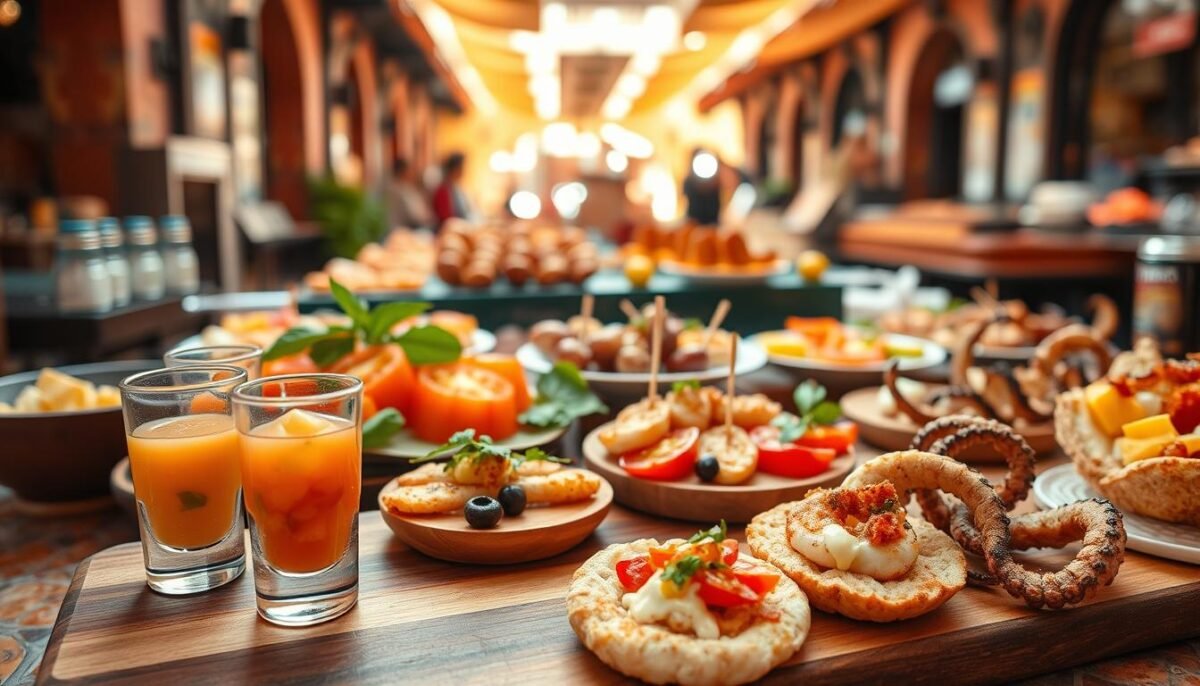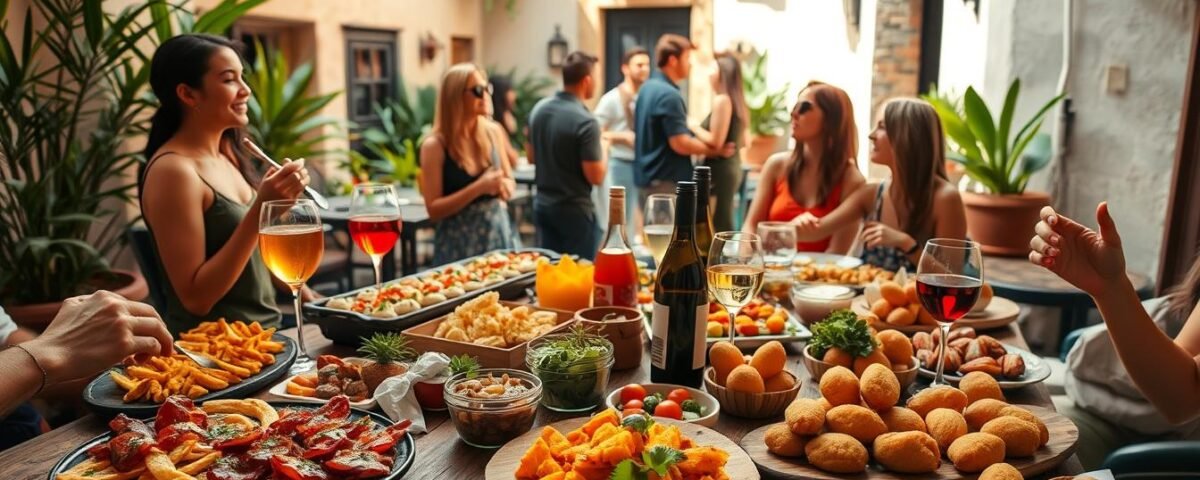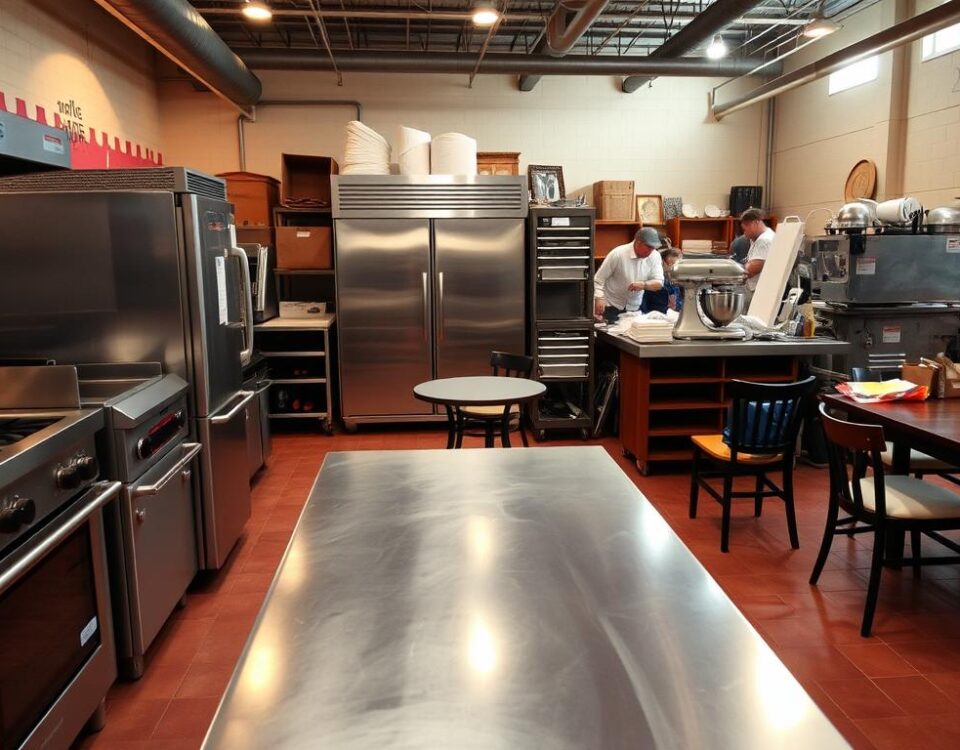
Mexican Street Food at Home: How to Make Tacos al Pastor
April 27, 2025
How to Recreate a Traditional Korean BBQ Night at Home
April 28, 2025I’ll never forget the first time I stepped into a bustling bar in Barcelona. The air hummed with laughter, clinking glasses, and the sizzle of garlic hitting hot olive oil. A waiter slid a small plate of golden shrimp toward me, their tails curled like smiles. That moment—simple, vibrant, and full of life—captured the heart of Spanish culture. It wasn’t just food. It was a celebration on a plate.
Back home, I craved that warmth. So I started recreating those small, shareable dishes in my kitchen. Turns out, you don’t need a plane ticket to host a fiesta. With fresh ingredients and a little flair, anyone can turn weeknights into something magical. My go-to? A quick garlic shrimp version that’s ready in 15 minutes. It’s become my secret weapon for impromptu gatherings.
This guide isn’t just about cooking. It’s about slowing down, savoring flavors, and connecting over good food. Whether you’re hosting a crowd or treating yourself, these dishes bring joy to the table. Let’s dive into the art of creating unforgettable moments—one bite at a time.
Key Takeaways
- Tapas transform meals into shared experiences, perfect for casual parties
- Fresh, quality ingredients elevate even the simplest dishes
- Many recipes require minimal prep time but deliver bold flavors
- Adapt traditional methods to create your own signature versions
- Pairing small plates encourages trying multiple dishes in one sitting
Introduction to Spanish Tapas: A Culinary Journey
The clatter of ceramic plates snapped my head around as I entered a sunlit bar in Valencia. What looked like edible jewelry crowded the counter—jewel-toned marinated olives, crusty bread slices topped with ruby-colored spreads, and silver dishes of briny anchovies. This wasn’t just food. It was conversation starter, history lesson, and love language all in one.
The Spirit Behind Small Plates
Locals taught me tapas aren’t about complexity. They’re about connection. A bartender once told me, “We don’t eat to live here—we live to eat together.” The tradition began centuries ago with simple bar snacks placed over drinks (tapar means “to cover”). Today, it’s a social ritual where strangers become friends over shared bites.
My First Bite of Magic
I still taste my inaugural tomato-rubbed toast. Charred bread met garlic-infused oil, fresh tomato pulp, and a sprinkle of sea salt. Three ingredients. One explosion of flavor. Beside it sat plump anchovies draped over citrus slices—their bold saltiness balanced by bright lemon. The magic? Each element sang on its own but harmonized beautifully.
| Ingredient | Basic Form | Tapas Transformation |
|---|---|---|
| Bread | Plain loaf | Crispy base for toppings |
| Olives | Simple snack | Herb-marinated mix |
| Anchovies | Pizza topping | Citrus-cured delicacy |
What stunned me most? Many authentic recipes take 15 minutes. A drizzle of olive oil, a handful of pantry staples, and suddenly you’re hosting your own fiesta. That’s the beauty—these dishes meet you where you are, then transport you somewhere extraordinary.
The Origins of Tapas: Tradition and History
In a Seville tavern’s archives, I found a 19th-century menu stained with olive oil. The yellowed paper listed just three items: bread rounds, salted almonds, and cured ham. These humble beginnings reveal how tapas grew from practical snacks into edible art.
Local historians explained how the iconic Spanish tortilla started as field workers’ fuel. “Farmers needed portable protein,” noted Madrid chef Javier Moya. “Their potato-and-egg recipe born from necessity became our national treasure.”
Coastal regions developed specialties using fresh catches. I tasted anchovies preserved in olive oil at a Valencia dockside bar—a method sailors used before refrigeration. Inland areas showcased earthy flavors like smoky peppers from Murcia.
| Time Period | Development | Key Ingredients |
|---|---|---|
| 1700s | Bar snacks cover drinks | Bread, olives |
| 1800s | Regional recipes emerge | Anchovies, peppers |
| 1900s | Chefs elevate dishes | Olive oil, potatoes |
What fascinates me most? These recipes became regional badges of pride. Olive groves in Andalusia inspired garlicky dips, while Basque cider houses perfected salt-cod bites. Every bite tells a story of communities adapting to their land.
That’s the magic—these dishes carry centuries of ingenuity. They remind us that great food isn’t about complexity. It’s about resourcefulness, shared history, and the enduring appeal of shared plates.
Key Ingredients in Spanish Tapas
My fingers still smell of garlic from last night’s kitchen experiment—a vibrant reminder of how core elements transform ordinary meals. The magic lies in pairing humble components with bold accents.
Olives, Cheese, and Spices
Marinated olives taught me balance. Briny Manchego cheese slices paired with honey-drizzled almonds became my go-to appetizer. Smoked paprika turns roasted potatoes into patatas bravas—crispy wedges crowned with tomato sauce.
| Ingredient | Role | Example Dish |
|---|---|---|
| Olives | Salty counterpoint | Herb-marinated mix |
| Smoked Paprika | Depth builder | Spiced almonds |
| Manchego | Creamy anchor | Cheese-stuffed dates |
| Garlic | Flavor amplifier | Shrimp in garlic oil |
| Sherry Wine | Acid balance | Wine-marinated chorizo |
Fundamental Flavors: Garlic and Wine
I once watched a chef rub raw garlic on warm bread—a trick that elevates toast to art. Dry sherry in sauces cuts through rich cheeses, while red wine reduces into glazes for meats.
Even basic bread becomes crusty canvases for toppings. Potatoes? Roast them golden and toss with sea salt. These elements don’t just feed the body—they spark conversation, one shared plate at a time.
Explore Spanish Tapas Recipe Ideas
Have you ever transformed pantry staples into a feast that sparks conversation? My kitchen adventures taught me that magic happens when you pair bold flavors with simple techniques. Let’s explore creative combinations that turn everyday ingredients into crowd-pleasers.

Seafood lovers will adore sizzling shrimp garlic bites—tossed in olive oil with chili flakes, ready in minutes. Meat enthusiasts? Try chorizo slices caramelized with honey and sherry vinegar. The sweet-smoky contrast will vanish faster than you can say “¡Otra ronda!”
Vegetarian options shine too. Roasted pepper strips draped over whipped goat cheese create a creamy-crunchy texture dance. Or toss juicy tomato chunks with basil and crusty bread for a vibrant panzanella-inspired bite.
| Base Ingredient | Modern Twist | Prep Time |
|---|---|---|
| Chorizo | Honey-glazed with almonds | 12 minutes |
| Serrano Ham | Wrapped around asparagus | 8 minutes |
| Chickpeas | Smoked paprika salad | 10 minutes |
What’s the secret? Let ingredients sing. A drizzle of aged balsamic elevates melon slices. Sea salt heightens dark chocolate-dipped oranges. Every element should surprise and delight—no fancy skills required.
Last week, I hosted friends using seven different dishes from this approach. The star? A five-minute ham and manchego stack with quince paste. Simple. Memorable. Unforgettable.
A Culinary Tour of Classic Tapas Dishes
The scent of caramelized onions stopped me mid-sentence at a Madrid café. A server placed a wedge of tortilla española before me—its layers of silky eggs and tender potatoes glistening like edible amber. This humble dish, perfected over generations, embodies the soul of shared meals.
Regional kitchens have honed their stars through time. In Castile, I tasted chorizo simmered in red wine—its smoky richness cut by tangy peppers. Basque country revealed cheese-stuffed piquillos, their sweetness balancing sharp Idiazabal. Each bite felt like shaking hands with history.
What makes these creations timeless? Resourcefulness. A 19th-century farmer’s lunch—eggs, potatoes, olive oil—became the iconic tortilla. Leftover bread transformed into salad bases with tomatoes and cucumbers. As chef Elena Martínez told me: “Our grandmothers wrote recipes with their hearts, not measuring cups.”
| Classic Dish | Key Elements | Modern Twist |
|---|---|---|
| Tortilla | Eggs, potatoes | Add caramelized onions |
| Chorizo al Vino | Sausage, red wine | Infuse with orange zest |
| Pimientos Rellenos | Peppers, cheese | Stuff with goat cheese |
These dishes invite playfulness. Swap Manchego for smoked gouda in stuffed peppers. Roast potatoes with rosemary instead of paprika. The foundation remains, but your kitchen becomes the canvas.
Ready to taste tradition? Start with the tortilla—crisp edges giving way to creamy centers. Then let your imagination wander. After all, every classic began as someone’s bold experiment.
Seafood Tapas: Delving into Garlicky Goodness and More
The sizzle of garlic hitting hot oil still makes my mouth water. Coastal kitchens taught me how seafood sings when paired with bold accents. Crisp white plates arrive bearing treasures from the sea—plump shellfish glistening in golden pools, their aromas whispering of Mediterranean breezes.
Gambas al Ajillo: A Flavor Explosion
I learned the magic of shrimp in garlic oil from a Valencia chef who swore by two rules: “Never overcook, and always use fresh crustaceans.” His version danced with chili flakes and a splash of red wine, transforming into a sauce worthy of bread-dipping marathons.
José Andrés wasn’t kidding about the 20-minute prep time. The dish comes alive fast—garlic slices caramelize while shrimp turn pink in the pan. Serve it straight from the skillet, with crusty bread to catch every garlicky drop.
| Ingredient | Traditional Version | Modern Twist |
|---|---|---|
| Shrimp | Whole, with heads | Peeled, tail-on |
| Garlic | Thin slices | Roasted cloves |
| Wine | Sherry | Lemon zest |
| Heat | Clay dish | Cast iron skillet |
What I love? These seafood stars turn Tuesday dinners into celebrations. Last month, I hosted neighbors with three variations—classic garlic, smoked paprika, and one with orange-infused oil. Empty plates and laughter proved the point: good food needs no translation.
Ready to ride the flavor wave? Grab your skillet and let the garlic work its magic. Your kitchen will smell like a seaside bar in minutes—no passport required.
Vegetarian Tapas Delights for Every Palate
The crunch of golden-brown potatoes hitting a ceramic bowl still makes my heart race. Vegetarian tapas taught me that plant-based dishes can steal the show—no meat required. From smoky roasted peppers to creamy cheese-stuffed mushrooms, these creations turn simple ingredients into flavor fireworks.
Patatas Bravas & Beyond
My obsession began with patatas bravas at a Barcelona café. Crispy cubes met spicy tomato sauce and cool garlic aioli—a textural tango that left me speechless. Chef Inés Ruiz once told me: “The secret? Contrast. Heat against creaminess, earthiness against brightness.”
Try pairing roasted red peppers with whipped goat cheese on crusty bread. Or toss grilled zucchini with lemon zest and eggs for a protein-packed bite. Even classic dishes get veggie upgrades:
| Traditional Dish | Vegetarian Twist | Key Ingredients |
|---|---|---|
| Tortilla | Spinach & mushroom | Eggs, greens |
| Pan con Tomate | Heirloom varieties | Tomato, basil |
| Ensaladilla | Quinoa base | Potatoes, olives |
Last week, I reinvented salad as tapas—charred romaine leaves with smoked almonds and manchego shavings. Guests raved about the crunch-factor. The lesson? Vegetarian doesn’t mean timid. With bold spices and smart pairings, every plate becomes an adventure.
Ready to explore? Start with those iconic bravas potatoes. Then let your pantry guide you—roasted veggies, fresh herbs, and good olive oil work magic. Your taste buds won’t miss a thing.
Regional Inspirations: Basque, Andalusian, and Galician Flavors
Rain-soaked hills in Galicia taught me how geography shapes flavor. Each region’s terrain whispers through its dishes—coastal brine in Basque pintxos, Andalusian sunshine in oil-cured olives, mountain herbs in Galician stews. These aren’t just meals. They’re edible maps.
In San Sebastián, I tasted chorizo skewered with crusty bread—a pintxo perfected over generations. “We thread meats while they’re cold,” explained a bartender, his hands moving like a jeweler’s. “Ensures even cooking.” Nearby, ham-wrapped dates balanced salty-sweet notes with surgical precision.
Andalusia’s heat demands boldness. At a Cádiz market, I found anchovies bathing in citrus baths beside jars of thyme-kissed olives. “Sun-ripened ingredients need little help,” a vendor winked, handing me a sample. The flavors exploded—sharp, bright, unapologetic.
| Region | Specialty | Key Ingredients | Technique |
|---|---|---|---|
| Basque | Pintxos | Chorizo, bread | Skewer grilling |
| Andalusia | Marinated fish | Anchovies, olives | Citrus curing |
| Galicia | Empanadas | Red wine, peppers | Hand-folded pastry |
Galicia surprised me most. Their empanadas’ flaky crusts hid red wine-braised fillings—a version born from fishermen’s need for portable meals. Biting into one felt like uncovering buried treasure: savory, hearty, steeped in salt-air history.
Together, these regional voices form a chorus. From mountain to coast, they prove that local ingredients—treated with respect—create unforgettable stories on a plate.
Essential Cooking Techniques for Delicious Tapas
The sharp crack of my knife splitting a potato still echoes in my kitchen. Texture makes or breaks great food—crispy edges, silky sauces, and tender bites that sing in harmony. Mastering these contrasts turns simple ingredients into unforgettable experiences.
Achieving the Perfect Texture
I learned the art of golden potatoes from a Barcelona chef who timed his frying like a symphony conductor. “Three minutes at 350°F,” he insisted, “then drain on paper—never metal.” This creates the crackling crust that defines classic patatas bravas.
For velvety sauces, reduce red wine by half before adding stock. A Madrid cook once showed me her trick: swirl cold butter into the pan off-heat. The emulsion clings to slices of bread like liquid gold.
| Technique | Traditional | Modern Version |
|---|---|---|
| Frying | Olive oil only | Duck fat + rosemary |
| Reductions | 1-hour simmer | Pressure cooker (15 min) |
| Vegetable Prep | Hand-cut | Mandoline for evenness |
Timing matters most. Overcook shrimp by 30 seconds, and they turn rubbery. Under-reduce a sauce, and flavors stay muted. I set multiple timers—one for the pan, one for prep, one for plating.
As chef Luisa Márquez told me: “Great dishes aren’t made. They’re orchestrated.” With practice, these methods become second nature. Your kitchen will hum with the rhythm of sizzling pans and chopping knives—a recipe for edible magic.
Artful Plating: Presenting Tapas with Style
A swirl of saffron aioli caught my eye at a Granada café—its golden streaks framing ruby-red peppers like edible artwork. That moment taught me plating isn’t just decoration. It’s storytelling. In Spain, even humble bread becomes a canvas for vibrant toppings, turning quick dishes into visual celebrations.

Tips for Visual Appeal
Start with contrast. Pair charred pepper strips with creamy white bean puree, or nestle emerald-green olives against sun-kissed tomatoes. Rustic slices of crusty bread anchor colorful toppings, while a crisp salad adds freshness as a side.
Think vertical. Stack manchego cubes between quince paste layers, or skewer marinated mushrooms with rosemary sprigs. A Barcelona chef once whispered: “Height creates drama—like edible architecture.”
| Element | Traditional Use | Modern Hack |
|---|---|---|
| Bread | Flat base | Toasted crouton scatter |
| Olives | Bowl cluster | Salt-rimmed trail |
| Peppers | Sliced strips | Flower-shaped cuts |
Last week, I transformed leftover chickpeas into art. Smoked paprika-dusted hummus formed swirls under blistered tomatoes, with fried capers adding crunch. Guests snapped photos before eating—proof that beauty deepens enjoyment.
Remember: every plate should whisper, “Come closer.” Whether arranging ingredients in concentric circles or drizzling sauces with abandon, let your creativity mirror Spain’s joyful spirit. After all, we taste first with our eyes.
Quick and Easy Tapas: Perfect for Weeknights
Weeknight dinners transformed when I discovered 15-minute flavor bombs. My tiny kitchen now channels Madrid bars through sizzling shrimp garlic and honey-glazed chorizo. These shortcuts prove fast food doesn’t mean bland food.
Pre-prepped ingredients are game-changers. Jarred roasted peppers become smoky bases for cheese stacks. Frozen pre-peeled shrimp hit the pan with olive oil and chili flakes—dinner ready before the rice cooker dings.
| Dish | Traditional Prep | Quick Hack | Time Saved |
|---|---|---|---|
| Shrimp Garlic | 30 mins | Pre-peeled shrimp | 15 mins |
| Chorizo Bites | Marinate overnight | Honey glaze | 20 mins |
| Salt-Vinegar Tortilla | Slow-cooked potatoes | Pre-cooked slices | 25 mins |
Bold flavors anchor these speedy dishes. Garlic oil pools around crustaceans, while sherry vinegar cuts through rich meats. Friends swear my express tortilla rivals Barcelona cafés—proof shortcuts don’t sacrifice soul.
Hosting spontaneous gatherings became effortless. Last Thursday, caramelized onion dip with store-bought crisps morphed into a party centerpiece. Laughter flows freely when the kitchen isn’t chained to recipes.
Reinventing Tradition: Innovative Twists on Tapas
The sizzle of almonds toasting in smoked paprika oil stopped me mid-bite. At a cozy Madrid eatery, a chef reimagined a classic shrimp dish by swapping breadcrumbs for crushed Marcona almonds. The result? A crispy, nutty crust that elevated every tender morsel.

That moment sparked my love for modern twists on tradition. Take patatas bravas—roasted sweet potatoes with harissa aioli now rival the original. Even simple tomato toast gets depth from roasted pepper jam.
A Barcelona cook once taught me the power of subtle changes. “Swap bell peppers for padrón,” she advised, handing me a blistered green bite. The difference was electric—mild heat dancing with garlic oil.
Innovation isn’t about erasing history. It’s writing new chapters with respect for the original story. Start with trusted recipes, then play with textures and accents.
Ready to remix tradition? Fold saffron into aioli for golden dips. Every experiment honors Spain’s culinary spirit while making it uniquely yours.
Perfect Pairings: Wine and Beverage Accompaniments for Tapas
What transforms good snacks into showstoppers? The liquid harmony swirling in your glass. At a Valencia vineyard, a winemaker taught me: “Pairings should whisper secrets about the dish—not shout over it.” This philosophy guides my approach to matching bold flavors with Spanish wines.
Choosing the Right Spanish Wine
Salty ham demands bright acidity. I reach for verdejo—its citrus notes cut through rich meats like a zesty counterpoint. For crispy bread topped with roasted peppers, try garnacha’s berry undertows. The sweetness balances smoky char without overpowering.
| Small Plate | Perfect Pair | Why It Works |
|---|---|---|
| Garlic Shrimp | Albariño | Mineral finish cleanses palate |
| Patatas Bravas | Cava Brut | Bubbles contrast creamy sauce |
| Marinated Olives | Fino Sherry | Nutty tones enhance brine |
Even simple recipes shine with thoughtful matches. A Madrid chef once served txakoli with honey-drizzled cheese—the wine’s slight effervescence lifted the creamy side dish. Crisp whites make fried snacks sing, while robust reds ground earthy stews.
Don’t fear experimentation. Try pairing citrus-marinated anchovies with verdejo. Or contrast spicy chorizo with tempranillo’s vanilla hints. Each combination reveals new layers in both wine and food.
Your turn: Grab two glasses and host a tasting night. Compare how rioja reshapes roasted vegetables versus how manzanilla brightens seafood. The best pairings? Those that make your side dishes taste like main events.
My Personal Tapas Journey: Bringing the Fiesta Home
It started with a sizzle—garlic hitting olive oil—that became my gateway to culinary adventures. What began as a weeknight experiment with shrimp and chili flakes transformed into a ritual. Each golden crust and smoky aroma carried me back to Valencia’s cobblestone streets.

My kitchen became a laboratory for textures. Crispy potatoes met paprika aioli, while roasted peppers danced with honey-glazed almonds. Friends marveled at how these small plates turned ordinary evenings into vibrant gatherings. One guest whispered, “This tastes like sunset in Barcelona.”
What surprises me most? A single tapa holds multitudes. Smoky chorizo elevates crusty bread into a meal, while marinated olives become more than snacks—they’re conversation starters. Every dish whispers secrets of shared tables and laughter echoing through warm nights.
Now I challenge you: light some candles, pour sangria, and let these flavors rewrite your dinner routine. Because the best fiestas don’t need passports—just an open heart and a hot skillet.
Hosting the Ultimate Spanish Tapas Party
The glow of candlelight reflecting off golden croquetas still takes me back to my first fiesta. I learned that atmosphere matters as much as flavor—soft flamenco guitar drifting through the air, mismatched plates crowding a rustic wooden board, laughter bouncing off terracotta walls.
Setting the Mood
Dim lighting transforms any space. I cluster tea lights around garlic-rubbed bread slices and drape fairy lights over serving trays. A Barcelona host once told me: “Guests relax when shadows dance—it feels like secrets being shared.”
Menu Planning and Layout
Balance textures and temperatures. Crispy patatas bravas nestle beside room-temperature tortilla wedges. I arrange bowls of marinated olives near chilled wine carafes—the contrast invites exploration.
Use tiered stands to showcase variety. Bottom level: crusty bread with tomato rub. Middle: citrus-marinated shrimp. Top: honey-drizziled cheese slices. This vertical spread becomes edible art that sparks conversation.
Remember: the best gatherings feel effortless. Prep ahead, then enjoy your own party. When guests linger over third helpings of patatas, you’ll know the magic worked.
Conclusion
The true magic of these small plates lies not in their size, but in the stories they carry. My journey through sun-drenched garlic-kissed kitchens and coastal seafood stalls revealed how humble elements—crisp potatoes, sharp manchego, golden olive oil—become edible poetry when combined with care.
One bite of smoky Spanish tortilla transports me to crowded bars where laughter clings to sizzling pans. A single tapa holds the warmth of shared tables, turning quick snacks into memories of late-night fiestas. These dishes aren’t just meals—they’re living invitations to connect.
Now it’s your turn. Let blistered shrimp in garlic oil or caramelized onion dips become your party starters. Host a gathering where crispy bread meets marinated olives, and watch strangers become friends. Every kitchen holds the power to create these moments.
Grab that skillet. Uncork the wine. Whether you’re crafting a full spread or one perfect plate, remember: great food thrives on joy, not perfection. Your part in this culinary story begins now.
FAQ
What defines a traditional tapa?
For me, it’s all about simplicity and sharing. Think small plates like marinated olives, crusty bread with Manchego, or garlicky shrimp. The key is bold flavors meant to be enjoyed socially.
Can I make tapas without seafood?
Absolutely! Dishes like patatas bravas (spicy potatoes), tortilla española (egg and potato omelet), or stuffed peppers are classics. I often use smoked paprika or saffron to add depth to vegetarian options.
What’s the best wine to pair with garlic-heavy dishes?
I lean toward a crisp Albariño or a fruity Tempranillo. Their acidity balances garlic’s intensity. For something bolder, try a Rioja with chorizo or aged cheese.
How do I keep fried tapas crispy?
I fry in small batches and use a wire rack instead of paper towels. For patatas bravas, toss them in sauce right before serving to maintain that crunch.
Are there quick options for weeknights?
Yes! Pan con tomate (tomato-rubbed bread) takes minutes. Or sauté chickpeas with spinach and smoked paprika. Even a simple plate of almonds and marinated olives works.
What’s a must-try regional variation?
Basque pintxos, like skewered anchovies or goat cheese with quince paste. Andalusian gazpacho shots or Galician empanadas also showcase Spain’s diverse flavors.
Can I prep tapas ahead for a party?
Definitely. Marinate cheeses, prep sauces like romesco, or roast peppers in advance. Assemble pintxos last-minute for freshness. I always keep crusty bread and cured ham on hand.
What’s your go-to tool for tapas?
A sturdy skillet for frying and a mortar for grinding spices. Oh, and small bowls for dipping sauces—presentation matters as much as taste!



